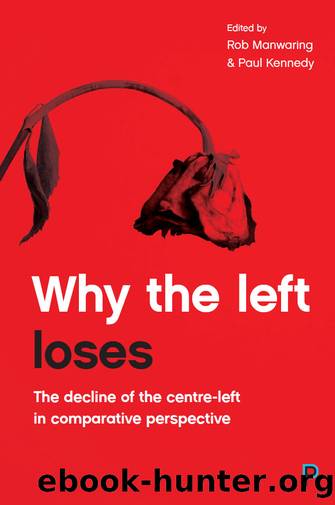WHY THE LEFT LOSES by Rob Manwaring & Paul Kennedy

Author:Rob Manwaring & Paul Kennedy
Language: eng
Format: epub
Publisher: Policy Press
Published: 2017-07-14T16:00:00+00:00
Institutions
The SPD faces a range of institutional and structural problems. There is a declining proportion of workers who are members of trade unions and who continue to support social democracy. During the last 40 years, most social democratic parties have sought to compensate for the decrease in their traditional support base by increasing their appeal to other social groups. The SPD has also pursued this strategy of trying to build a cross-class coalition of support. Since the 1990s, this has largely been carried out via the implementation of a 'catch-all' strategy. This involves utilising modern forms of party organisation, appealing to the 'centre ground' and adopting a more pragmatic style of politics (cf Jun, 2004). However, modernisation has also caused the SPD to lose support and alienated certain traditional groups of supporters, resulting in the irreversible loss of this group of former core voters. This shift has nevertheless simultaneously attracted new groups of voters and led to electoral success in the era of Chancellor Schröder.
The ability to change is a fundamental characteristic of the social democratic family of parties, a quality that also applies to the SPD's chief competitor in the German party system, the CDU. Research shows that in recent years, both the major parties in the German party system have diverged (cf Niedermayer, 2015). Unlike, the SPD, the CDU/CSU has renewed itself, by partially modifying or revising its programmatic traditions in order to adjust to the electorate. In contrast, the SPD has emphasised its statist tradition (notably in 2005 and 2009) by highlighting its core brand of social justice in its party programmes. Further, the SPD's decision not to fundamentally rescind Agenda 2010 in full has facilitated coalition building with the CDU/CSU. Sigmar Gabriel managed to close the gap between modernisers and traditionalists in the party. However, although the integration of the different party factions led to intra-party consolidation, it did not significantly increase the party's share of the vote at the 2013 election.
We can also detect shifts in the major parties in other policy areas. In relation to the socioeconomic axis in the two-dimensional space, both parties shifted towards the left (that is, towards state interventionism). This is indicated by the main decisions in the coalition agreement (for example, the retirement age and minimum wage policies). In relation to the socio-cultural axis, the CDU/CSU was formerly the only party that favoured authoritarian values. However, over recent years, it has shown a clear programmatic shift in policy areas such as family policy and migration policy. Notably, in its migration policy, the CDU abandoned the restrictive attitudes and authoritarian values that it held for decades.
During the Merkel era, the CDU has moved towards the political Centre across both dimensions of competition to ensure that it remains capable of winning a majority. Merkel has been able to enforce her programmatic visions within the CDU due to her pragmatism and her recognition of the need to secure a majority at elections, as the decision-making process focuses on the party leader and Chancellor (cf Zolleis and Schmid, 2014, p 29).
Download
This site does not store any files on its server. We only index and link to content provided by other sites. Please contact the content providers to delete copyright contents if any and email us, we'll remove relevant links or contents immediately.
American Kingpin by Nick Bilton(3510)
Future Crimes by Marc Goodman(3374)
The Meaning of the Library by unknow(2388)
Inside the Middle East by Avi Melamed(2233)
Why Nations Fail: The Origins of Power, Prosperity, and Poverty by Daron Acemoglu & James Robinson(2177)
On Tyranny by Timothy Snyder(2130)
Living Silence in Burma by Christina Fink(1984)
Putin's Labyrinth(1902)
The Mastermind by Evan Ratliff(1830)
The Smartest Kids in the World by Amanda Ripley(1686)
Think Like a Rocket Scientist by Ozan Varol(1678)
Law: A Very Short Introduction by Raymond Wacks(1636)
The Rule of Law by Bingham Tom(1594)
It's Our Turn to Eat by Michela Wrong(1593)
Leadership by Doris Kearns Goodwin(1563)
A Dirty War by Anna Politkovskaya(1543)
Philosophy of law a very short introduction by Raymond Wacks(1542)
Social Media Law in a Nutshell by Ryan Garcia & Thaddeus A Hoffmeister(1451)
Civil Procedure (Aspen Casebooks) by Stephen C. Yeazell(1440)
